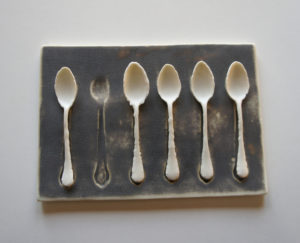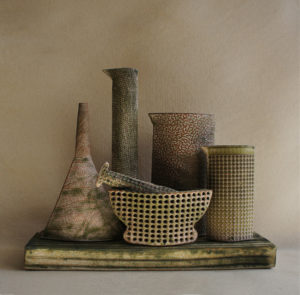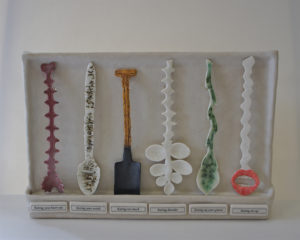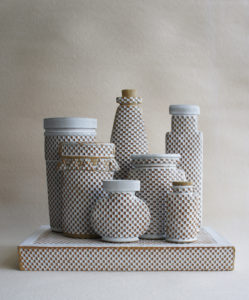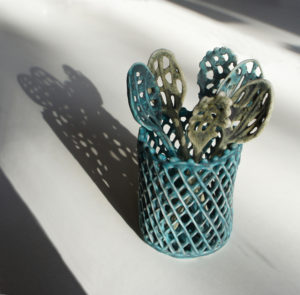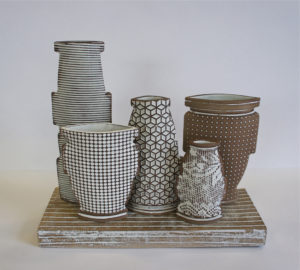Artists Statement
Getting Started:
I first discovered clay at school – my art teacher was learning to throw at the local art college and taught us as she learnt. I was enthralled by the feel of clay and mesmerised by the wheel although then I mainly modelled figurative pieces alongside heavy coiled bowls. I soon discovered the drawbacks, my ‘A’ Level piece called ‘Repose’; a seated, pregnant woman, blew-up in the kiln and had to be glued together for assessment. My A level choices, Art, Home Economics and Chemistry seemed to some a strange combination but somehow they have been perfect for a career in ceramics.
I did a foundation year in St Alban’s thinking I would become a potter but some how changed track and ended up becoming a Graphic Designer and Typographer. About 8 years later I returned to College to start a ceramics course in Rochester. Peter Philips who ran the course was fantastic at getting an eclectic mix of tutors to teach us. Geoffrey Whiting, David White, Peter Beard and Colin Pearson were weekly visitors. Sidig El NaGoumi, Karen Hessenburg, John Pollox, Jane Hamlyn, Sarah Walton and several others came to do blocks for two or three weeks at a time. There often seemed to be more staff than students and I was exposed to an incredible wealth of expertise. Another visiting lecturer, David Barnes, gave me a weekend job throwing mugs and making soap dishes for his party-plan business.
Although the course was very traditional, I was still able to explore numerous ideas and experiment with many ways of working.
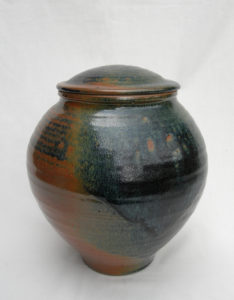
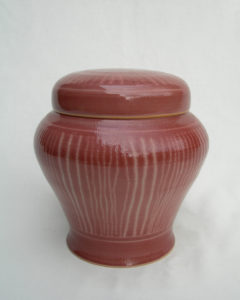
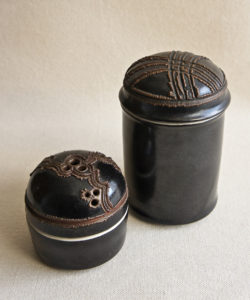
Geoffrey Whiting was perhaps my greatest influence at Medway. He helped me to understand form and function as well as the intrinsic beauty of clay. He held weekly sessions of “bring a pot” and we deliberated the angle of a spout, the size of a foot, the rim of a mug or the spring of a curve. I found it captivating and he gave me the ability to really look and analyse functional ceramic design as well as enhance my appreciation of abstract beauty. He also said “if you want to sell anything make it shiny and blue” and he hated shiny and blue.
Earning a living:
On leaving college I set up my own studio in Faversham, Kent and also got a job teaching for Adult Studies. My own work was mostly functional, reduction fired and heavily influenced by the Leach tradition. I made mugs and jugs and sets of casseroles, vases, bowls and trinket boxes using tenmoko and celedon glazes but often ‘shiny and blue’. I sold though party-plan and to local craft shops, at craft fairs and undertook commissions. I enjoyed making useful objects. I love the processes of making in clay. I love the individuality of the handmade even when repeating the same object. I am interested in repetition and modularity both in nature and the man-made, how things repeat and fit together seems essential knowledge for a potter.
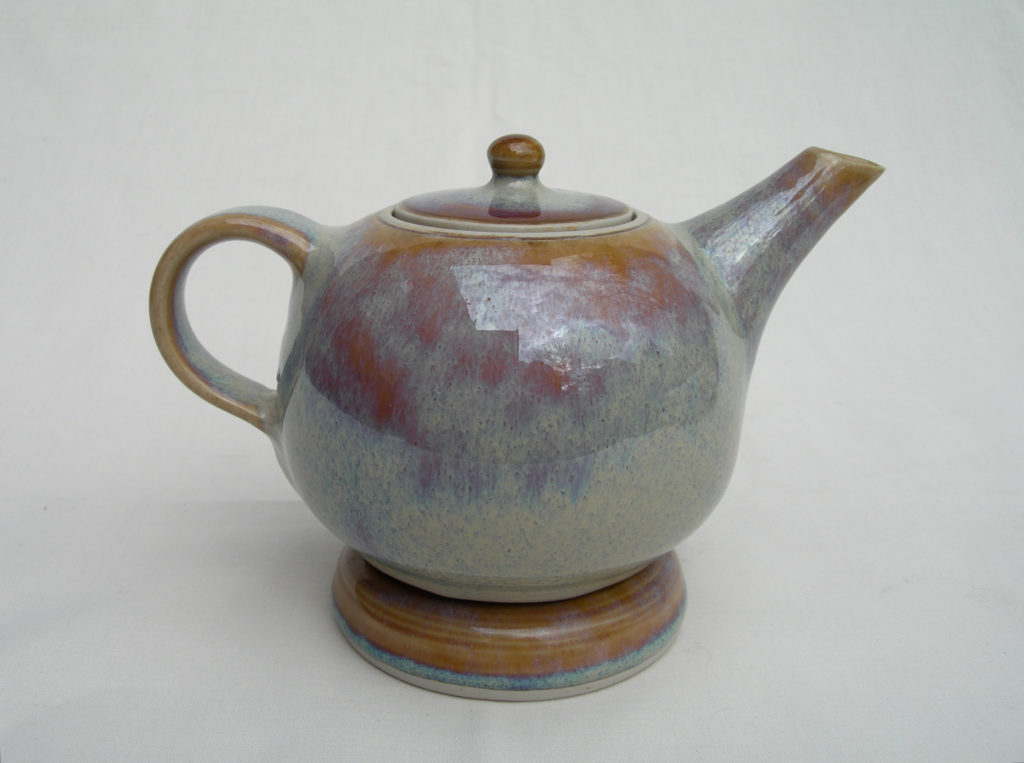
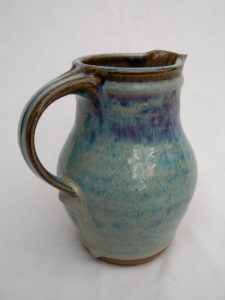
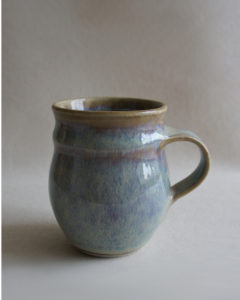
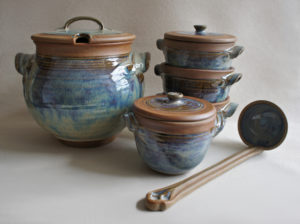
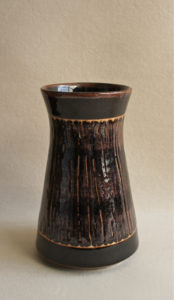
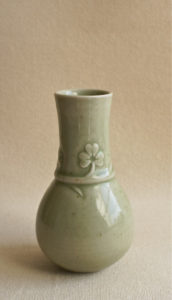
When I became the Ceramics tutor at Canterbury Christ Church University in 1990 the impetus to sell work became less demanding. I could survive financially on the teaching alone. I had time to experiment, I played with glazes, surface and making methods, my work became more sculptural, I had time to think through making, my work became larger and more individual.
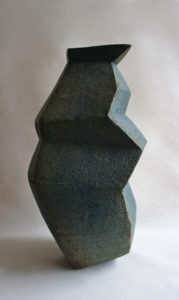
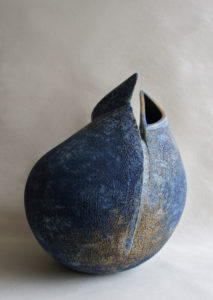

Of course, the balance of teaching and my own practice became more difficult when I became full-time. I started the MA Ceramics Programme as well as becoming Programme Director for Fine & Applied Arts, and thus teaching and its administrative demands became more dominant. However, it also afforded me many opportunities to meet artists, to exhibit and also there was the joy of teaching a subject one loves.
Changes of direction:
I think the demands and rhythm of teaching has meant my work seems to have gone in cycles, sometimes ideas can get used up even when you haven’t got the time to physically make all the work one plans. The central concerns I have had about repetition and making groups of forms, profile and drawing which often leads me to flattening forms seems to recur in different guises. I am interested in contrasts of loose surfaces and tightly drawn edges. I am looking for balance but that doesn’t mean symmetry. I like the ubiquity of clay, which often belies the pleasure and sentiment that clay objects can hold. I acknowledge that there is a strong design element to my work, which may come from my graphics background even though I greatly admire the freedom in the works of other artists.
In 2004 I had a sabbatical at the International Ceramics Studios in Hungary, a definitive time when I worked alongside Paul Soldner, Maria Gezlar, Ilona Romel, Jo Bova and others. I had already begun to experiment with how line could be both a surface and contain space. I somehow wanted to integrate line, form and surface. I worked with porcelain using moulds and slip-casting methods to explore these thoughts. I also experimented with piercing. The added bonus was I could also exploit light and shadow.
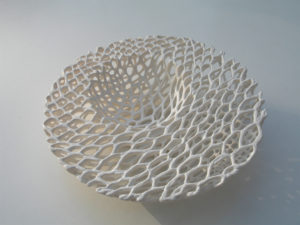
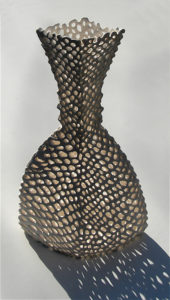
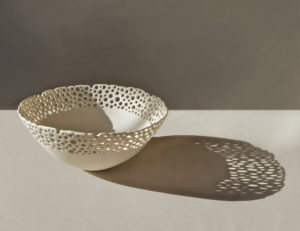
When I returned home I was offered a one man show in the Sidney Cooper Gallery, Canterbury and alongside my ‘reticulated’ work wanted to make a large installation that had been forming in my head since making a modular hanging about a streak of vivid blue sky glimpsed through clouds. I gratefully worked at ‘Potclays’ to make the bulk of this installation ‘White Earth, Blue Sky’, and fortunately managed to get some other sponsorship. The piece needed 1.25 tonnes of extruded porcelain, 630 stainless steel rods and 42 large pierced concrete blocks. It was a feat and my thanks go to many staff and students who helped me to make, glaze and construct the work. I hope at some point this can find a permanent home.
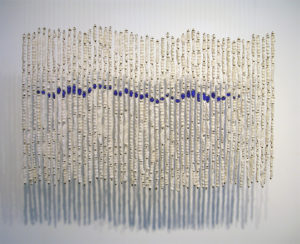
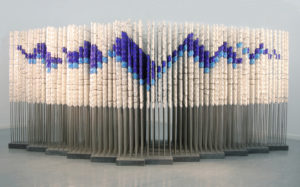

Recent concerns:
Maybe I have got large scale work out of my system as more recently my work has become smaller. Still concerned with groups of objects, my ideas have encompassed shelf based still lives. The objects are often textured and flattened and nestle against the wall. The harmony is created with uniform monochrome glazes. The shapes are familiar, understood but somehow out of context.
I have also been making groups of spoons, ubiquitous but intimate utensils, often laden with meaning and memory, beautiful, fragile, useless useful objects.
